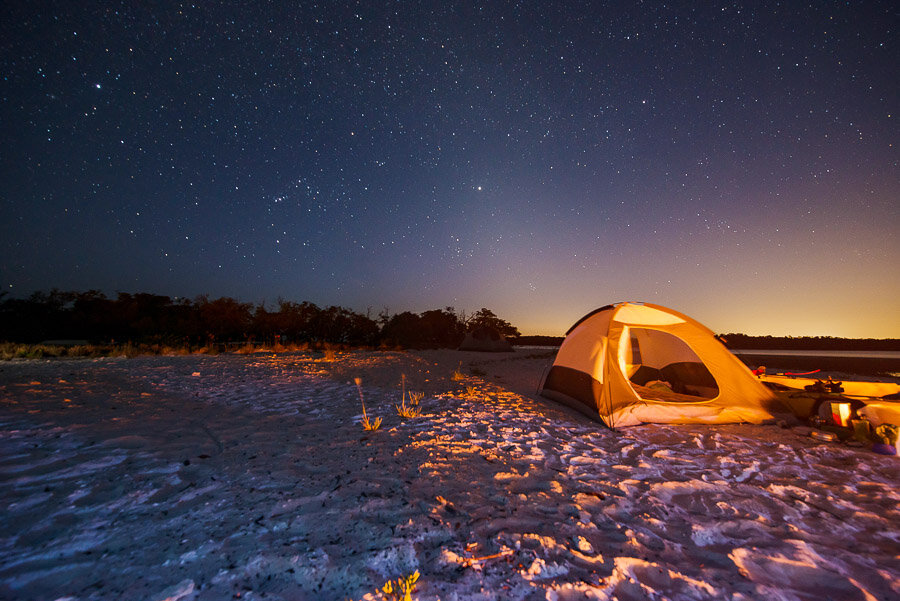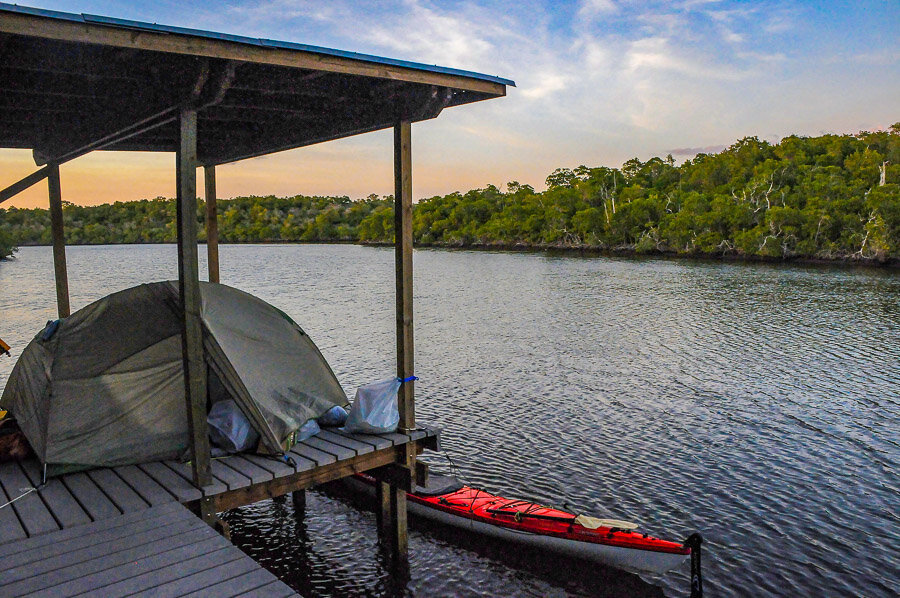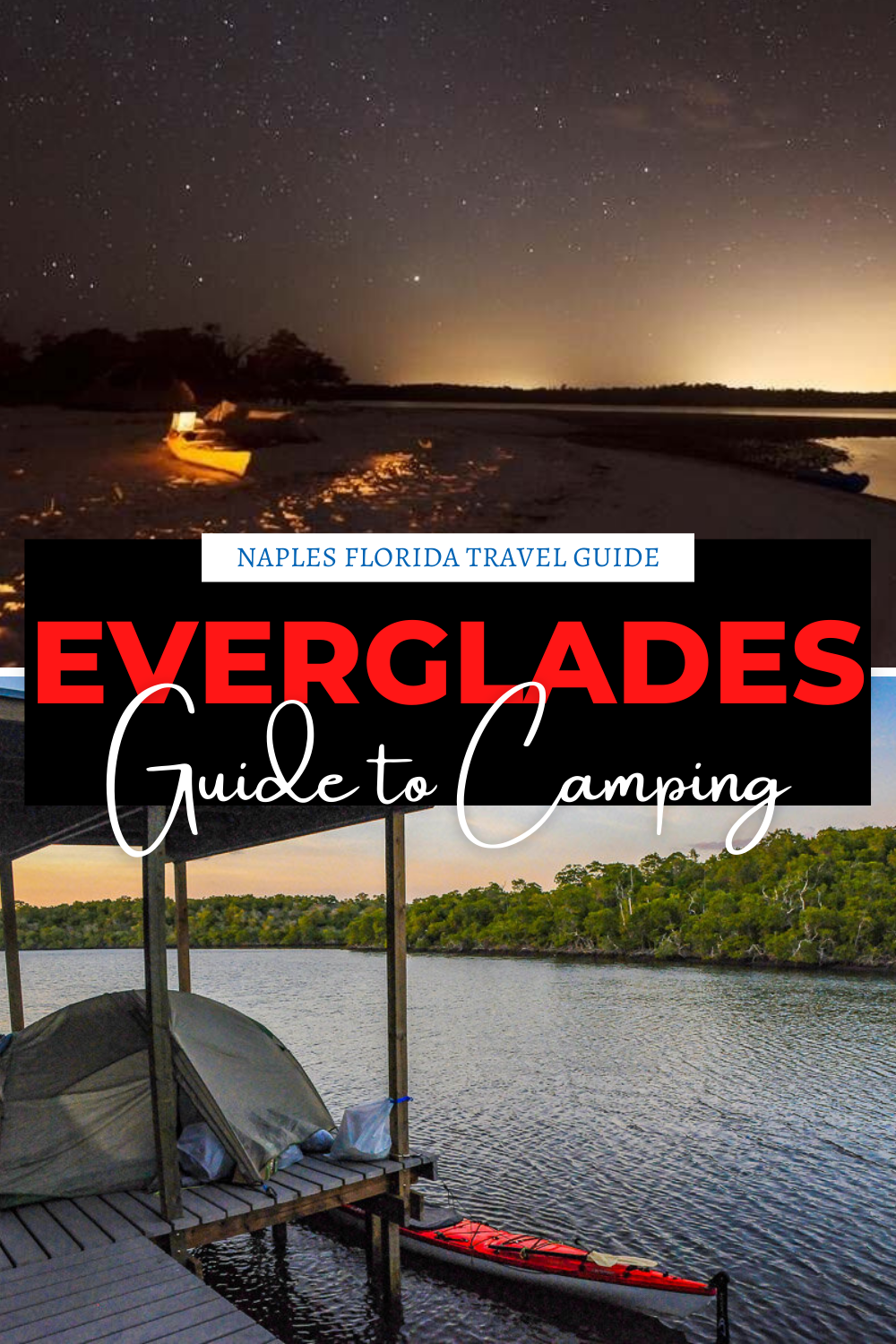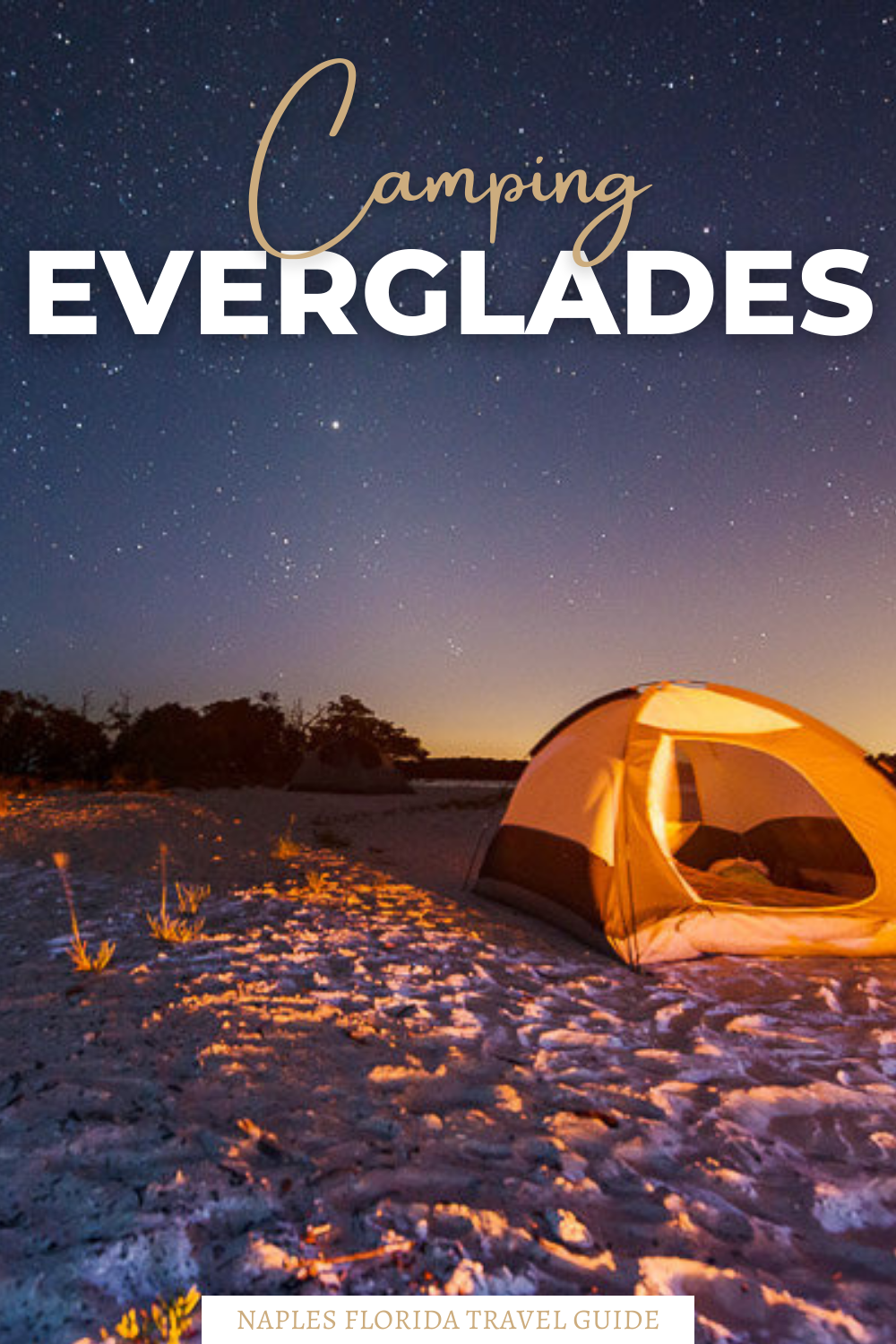Everglades Camping: Where and How to Go Camping in the Florida Everglades
Looking to immerse yourself in the wild side of the Florida Everglades and do some Everglades camping?
It’s one of the most awesome ways to experience the raw and rustic beauty of this amazing ecosystem.
But how exactly do you camp in the Everglades, a rugged environment that many refer to as a swamp?
Where can you pitch a tent safely, or park your RV, or paddle in quiet solitude and camp under the stars without another soul in sight?
From rustic, backcountry beach camping to cushy glamping-style tents that turn camping in the Glades into a southwest Florida bucket list adventure, there is a camping style for you.
Whether you’re looking to paddle and chickee hut camp, go RVing, pitch your own tent, or experience the Everglades in style, let’s dive in and find out just what kind of Everglades camping is right for you.
What’s In the Everglades Camping Guide?
(Click to Jump Ahead)
Different Types of Everglades Camping
Everglades Camping Near Naples
If you’ve always wanted to go Everglades camping, this guide is for you.
Different Types of Everglades Camping
If your idea of an Everglades experience is communing with nature and not necessarily speeding across the water on an airboat tour, you’re going to love camping in the Glades.
And while it may seem like we’re stating the obvious, let’s talk about how to actually go camping in the Everglades.
Unless you’re taking a road trip through Florida, it’s not so easy to just pull off the side of the road somewhere, or find a last-minute campground in the middle of the Everglades.
First off, hours of operation at Park Offices and campgrounds are highly seasonal and staffing may be limited or may wear many hats.
The old adage Gone Fishing is often all too true in the Everglades!
Fun fact about the Everglades: it is thousands of acres of vast wilderness with various unique habitats.
As a result, there are several ways to go Everglades camping and experience this wilderness, as we outline below.
Take a look and see what kind of camping may be right for you, given the equipment needed, your experience level, and the type of camping experience you wish to have.
Tent Camping
There are two seasons in south Florida: the dry season from December to May and the wet season from May through November.
Tent camping exposes you to the raw elements.
Daytime temperatures in the dry season can reach the high 80s, but temps can fall into the 40s or even cooler at night.
During the wet season the temperature can often reach 100 along with high humidity.
Pack light but take what you need to stay comfortable depending on the time of year — a solid tent with a good rain fly, warm sleeping bags, rain gear, and anything else that you would normally take camping.
Everglades Chickee Camping
Everglades chickee camping in elevated chickee huts is an adventurous but cool way to go camping in the Everglades.
What exactly are chickee huts? They are simply elevated platforms standing in and above the water.
The wooden platforms are based on a native Seminole design from the mid-19th century.
They often have a thatched roof and are open on all sides.
There’s usually an enclosed toilet located on the platform’s walkway sometimes shared by campers on adjoining huts.
You have to have a free-standing tent as you’re not allowed to put nails or stakes into the platform.
No fires are permitted so a gas stove is a good idea, and you’ll have to take all your trash with you when you leave.
If you want to have a unique wilderness campout, you won’t soon forget chickee hut camping in the Everglades.
Chickee hut camping in the Everglades is a bucket list experience for outdoor lovers
Beach Camping
With good weather beach camping can be a lot of fun and most sites are remote without a potable water source.
Several outfitters offer kayak and canoe rentals and will get you to a beach camping site.
Again no fires are allowed and leave only footprints.
Camping at Everglades National Park
A wilderness camping permit is required for all wilderness campgrounds, and are only issued one day prior to your arrival at the Gulf Coast and Flamingo visitor centers.
While electric hook ups for RVs are available at Flamingo, the watery backcountry of the Everglades has only primitive beach camp sites.
For more information contact Everglades Guest Service for information and reservation.
Camping at Everglades National Park is a perfect way to watch the sun rise
Everglades Camping Near Naples
Cabins and Chickee Huts
1. Native Chickee Cabins at Trail Lakes Campground
40904 Tamiami Trail E, Ochopee
Want to immerse yourself in the Everglades for a night or two?
There are two elevated chickee huts with thatched roofs at the Trail Lakes Campground that are perfect for those looking for a stay in the Everglades!
The huts are styled after the original Seminole chickee huts.
When you don’t have your own tent or camping gear with you, but you still want a unique overnight experience , these chickees offer a quiet camp surrounded by nature.
The Chickee cottage with solar fixtures and shutter windows has views of the swamp and open grasslands.
Neither of the two chickee huts have running water, but situated restrooms and hot showers are nearby at the Trail Lakes Campground bathhouse.
Chickee huts have great big decks and are a great opportunity for large families and groups to set up their own camp.
Chickee Chobee $199 (Sleeps up to 5)
Chickee Cottage $179 (Sleeps up to 3)
2. Nature Retreats at Clyde Butcher’s Big Cypress Gallery
52388 Tamiami Trail E, Ochopee
If you’ve explored the Florida Everglades from an airboat, and would like to learn more about this amazing wilderness, then book a stay at one of the Nature Retreats at Big Cypress Gallery located about an hour east of Naples on US 41 (Tamiami Trail).
Located adjacent to Everglades National Park, Big Cypress is one of our favorite places to experience nature in all of southwest Florida.
Formerly the home of renowned photographers Clyde and Niki Butcher for over 20 years, the accommodations place you in a pristine natural environment, while also providing you with modern amenities.
Set behind the gallery on 13 private acres of lush subtropical wilderness in the heart of Big Cypress National Preserve, there are two retreats: the 1BR Swamp Bungalow or the larger 2BR Swamp Cottage.
During your stay, experience the Glades up close and personal by taking a guided hike or guided Everglades swamp walk.
There’s the 2 hour Private Guided Swamp Walk Eco Tour or the 4 hour Private Photography Swamp Tour.
Overnight guests receive a 20% discount on either tour, and both tours welcome families with kids of all ages.
3. Miller's World Glades Haven Cozy Cabins
801 South Copeland Ave, Everglades City
Their name says it all! Located just minutes away from Chokoloskee Island Park, these comfortable and “cozy” cabins at Miller’s are located right on the edge of Everglades National Park where you can stay without sacrificing on creature comforts.
If you are looking for more of an adventure, you can rent a canoe, kayak or powerboat to go fishing or sightseeing.
Every cabin features a private bath and a kitchen with a refrigerator and coffee maker.
There is a heated swimming pool and a boat dock close by.
Glamping Near Naples
Safari Glamping
Everglades Adventure Tours, Ochopee
Glamping — or glamorous camping — is a fun way to get a bit rustic while still enjoying some basic creature comforts of wherever you’re visiting.
It’s an upscale way to experience the Everglades, especially for those visitors who have travelled long distances and are unable to bring the heavy camping gear necessary for a successful outing.
If you’d like to experience the sights and sounds of the Everglades in style, Everglades Adventure Tours can help you do it.
They’ll ensure that your family or group will have everything set up for you by their own guides including camp cots, sleeping bags, additional smaller tents, and firewood.
Other options offered are freshly prepared meals cooked as you like.
Safari glamping is organized at the Trail Lakes Campground where there are well-appointed tents and RV campsites.
Beach camping near the southern Everglades is rustic camping at its best.
Tents and RV Camping
1. Trail Lakes Campground
40904 Tamiami Trail, Ochopee
Run by the Shealy family for four generations, the Trail Lakes Campground showcases Florida like never before with their old-fashioned camping ground in the Everglades.
The Shealy's are traditionally Gladesmen, who have been residents of the Big Cypress swamps for generations.
When you go glamping here, you get a front row seat to the natural wonders of the Everglades through the knowledge and expertise of a Gladesman, but also get the best eco-tourism experience in Florida.
2. Big Cypress Nature Preserve camping
Ochopee
The clear waters of the Big Cypress swamp ecosystem provide refuge to the endangered Florida panther. Established in 1974, this happened to be the first national preserve of America.
Apart from camping the Big Cypress Nature Preserve has amazing night skies where visitors can marvel at the wonders of the Milky Way and other stars with just the naked eye.
There are eight campgrounds in Big Cypress and bookings can be made for 4 campgrounds: Burns Lake Campground, Monument Lake Campground, Pinecrest (group camping only), and Midway campground.
The campgrounds at Pink Jeep, Gator Head, Mitchell Landing and Bear Island are on a first come first serve basis. Plan your visit.
3. Chokoloskee Island Park
1150 Hamilton Ln, Chokoloskee
Chokoloskee Island Park has 35 RV sites and a handful of tent sites but the main attraction here is the waterfront location with a marina and direct access to the Ten Thousand Islands for fishing, birding and kayaking.
There are more than 60 boat slips, and bonus — it’s just around the corner from the Havana Cafe, a tasty local restaurant serving Cuban style food that you have to try.
Camping at Everglades National Park
Backcountry Chickee Huts
Everglades National Park camping is such a unique experience.
If you love camping, you need to go Everglades chickee camping. Chickee huts are elevated camping platforms erected in the water with a thatched roof and open sides.
The huts are originally a Seminole design started in the mid-19th century that were used for basic sleeping, eating, and cooking while overnighting in the Glades.
A chickee hut accommodates only free-standing tents.
No nails or stakes are permitted, and no fires are allowed on the platform.
Usually a walkway will lead to a small toilet but as with many conventional campsites, you’ll need to bring your own toilet paper.
For chickee hut camping, you’ll need to bring sufficient water, food, insect repellent, sunscreen, rain gear, and something to put your trash in.
And, you’ll have to take all of your trash back out with you.
Remember that chickee huts are elevated so plan accordingly on how to get in and out of your kayak or canoe.
Some sites will have a ladder making it far easier to enter and exit your paddle craft.
Go fishing, take memorable photos, and watch the sunset over the Glades.
Chickee hut camping is an experience you’ll not soon forget.
For more information on wilderness camping at Everglades National Park, visit the Park Service website.
Tents and RVs
There are two drive-in campgrounds accessible from the Homestead entrance of the park: Long Pine Key Campground that offers Everglades RV camping, and Flamingo Campground.
Both accommodate tents and RV's with a limited number of group sites. Reservations can be made with Everglades Guest Services or by calling 1-855-708-2207.
1. Long Pine Key Campground
Homestead
The Long Pine Key Campground is located seven miles from the main park entrance, just beside the Long Pine Key Trail and has all the amenities that are needed to spend quality time in nature.
The campground features restrooms, water refill points, a dump station, and cold showers.
Camps are booked on a first come first serve basis.
RV sites are however limited so visitors are advised to call ahead.
This diverse habitat of pinelands in the Everglades makes camping here a very special experience, as almost all of the pine trees were logged-out before the park opened.
2. Flamingo Campground
Flamingo Lodge Hwy, Homestead
Spending the night under the stars is one of the best ways to gain an appreciation for the Everglades ecosystem, and the Flamingo Visitor Center is just the starting point for a unique camping experience.
Located 38 miles from the entrance to Everglades National Park, this Everglades campground is situated in an open area cooled by breezes from Florida Bay.
Pick up your backcountry camping permit at the Visitor Center then head next door to the Flamingo Marina for canoe rentals.
You can even make arrangements with the friendly staff for canoes to be dropped off and picked up at the Hell's Bay canoe trailhead.
The campsite has showers, picnic tables and even an amphitheatre for winter programs, and accommodates a limited number of people in their eco-tents which add all the modern comfort needs.
In case of adverse weather conditions, the eco-tents can easily be moved to a safer place.
According to new proposals, posh cabins built from shipping containers are in the works for a cool and comfortable stay.
The Flamingo campground offers a number of ways to camp, including these comfy glamping tents
Everglades Camping: What to Know Before You Go
The Florida Everglades and Everglades National Park offer visitors one of the most unique and natural environments on Earth, and there are several good choices for camping in the Everglades either in the front country or the wilder backcountry.
A majority of the backcountry sites are accessible by kayak, motor boat, or canoe while a few can also be reached on foot.
Here are some important things to keep in mind as you plan your camping experience.
1. What to Bring
First and foremost, the Florida Everglades are in the subtropical climate zone, so during a large part of the year it’s hot — really hot.
We’re talking from the mid-80s into the mid to upper-90s.
Add high humidity during the wet season, and you have a recipe for heat-induced problems like dehydration, heat exhaustion, and worse, heat stroke.
Here are some things you’ll need to stay safe and comfortable:
Water
Lots of it, to stay hydrated and avoid a more serious condition.
The most often recommended is 2.6 - 3.7 liters per day depending on you’re body weight and degree of exertion.
It’s more effective to drink at small time intervals rather than infrequently gulping all at once.
Protective clothing
There are many good vendors producing UPF rated clothing made for this harsh environment.
A good sunhat with a wide brim is extremely important.
Consider a UPF rated long sleeve shirt like those worn by sailors and anglers.
If you sunburn easily there are even gloves to protect the back of your hands.
Sunscreen
A must! Be sure to have enough to protect those exposed areas for the length of your stay.
For this environment it should be no less than SPF 30 or 50 all the way up to SPF 100+.
Choose what is best based on your sensitivity to the sun and apply it often.
Insect repellent
You can’t avoid the things that bite especially in shady areas and at sundown.
Mosquitoes and no-see-ums can cause a whole lot of itching and ruin your adventure in one night.
Best not to let them get too close. And while we’re on the subject, bring along something to ease itching from bites.
We keep a stick of After Bite in with our gear.
You’ll see alligators — maybe many of them — when you go camping in the Everglades.
2. Snakes and Alligators (oh my!)
Everyone who visits us asks, “Will we get to see alligators in the Everglades?”
The answer is yes, most of the time.
Here’s what to do if you encounter one:
A common misconception is that an alligator will run you down.
This is not true.
Alligators can be aggressive and are able to turn quickly, but won’t chase you.
They are opportunistic ambush hunters, so it’s best to always give them a wide berth in and out of the water.
If you’re camping on either salt or brackish water, you’re not likely to come across any alligators.
They instinctively avoid these waters preferring fresh water habitats.
If you’re paddling in fresh water, stay in your kayak or canoe.
There are documented tragedies about folks who have foolishly decided to cool off by taking a dip or allowed a child to walk in the shallow water.
Use common sense. Just because you can’t see them doesn’t mean that they aren’t there.
“What about snakes?” The Everglades are composed of swamp land, hammocks, and marshes making a perfect habitat for various snake species, some poisonous.
This is another common sense thing. If you can’t see under something, don’t stick your hand in.
Snakes want to avoid you as much as you want to avoid them so this shouldn’t be a problem while camping.
Always check your hiking shoes or any footwear and give them a good shake before you put them on, especially if you leave them outside your tent or hut to dry.
Burmese pythons in the Everglades have received a good bit of media attention.
This invasive species is now spread across a thousand square miles of southern Florida, including all of Everglades National Park and areas to the north including Big Cypress National Preserve and Collier-Seminole State Forest.
If you encounter a python, take the same precautions as you would with an alligator and report your sighting to a park ranger when possible.
3. Government Resources on Everglades Camping
The Florida Fish & Wildlife Conservation Commission is a great resource and there’s a lot of useful information on their site — fishing regulations, viewing wildlife, and recreational opportunities on wild lands.
The US National Park Service is another great resource for Everglades camping. They post what campgrounds are open and which are closed.
There’s great information on Frontcountry Camping and Wilderness Camping.
It’s important to realize that not all of the Florida Everglades is in Everglades National Park.
Big Cypress National Preserve and Fakahatchee Strand State Preserve make up a large part of the Glades west and north of the National Park.
This means visitors should familiarize themselves with the governing agency whose regulations may differ depending on whether it’s federal or state land.
The Florida Everglades is a wet and wild region of tropical wetlands spanning the entire southern tip of Florida.
Going for a day trip to the Everglades is one thing, but spending a few of nights camping in the Everglades environment is a different matter altogether.
The size of the Everglades is vast, and there is so much to see in this massive natural environment.
It’s imperative that you’re well-prepared for the kind of Everglades camping you’re setting out on.
No matter which camping or glamping site you have in mind, there’s a spot out there that will suit your style.









